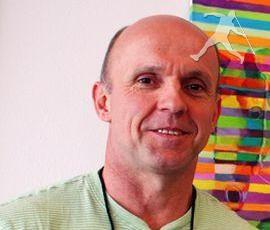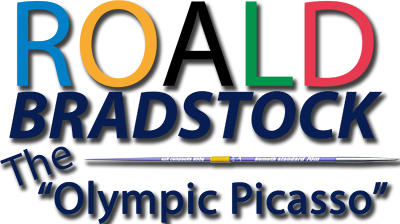
10 Apr Art and the Olympics
By Roald Bradstock – 10 April 2009
As an artist and an athlete I find the recent discussion about the “The Cultural Olympiad” and its role in the Olympics very interesting. A journalist wrote in an article recently that “it” would “be a tiny side show” to the Olympics and Paralympics in 2012.
Unfortunately this is a point of view that many people may have, but what amuses me is that art and the arts is so intertwined with the Olympics that people cannot see it.
 They are one and the same. Art and artistic ideas and concepts are all over the Olympics. Art has effected sports and the Olympics and vice versa. Art is the Olympics and the Olympics is ART!
They are one and the same. Art and artistic ideas and concepts are all over the Olympics. Art has effected sports and the Olympics and vice versa. Art is the Olympics and the Olympics is ART!
When you look closely and think about it the connection between sport and the arts it becomes clearer. In fact, I would argue that one of the reasons the Olympics is so big is exactly because of the artistic and cultural aspect.
The most obvious connection is the opening and closing ceremonies: the dancing, the music, and the fireworks – it is a show, a carefully choreographed show – it is theatre.
Look at sports like synchronized swimming, rhythmic gymnastics and figure skating. Moving to music – isn’t that dancing?
When you start looking behind the scenes and see how athletes train, perform and reach peak fitness to get to the Olympic and Paralympic stage you see the synergy between sport and the arts.
Have you ever seen the training programme of a world class athlete: the structure, the detail that goes into it and the planning – is it that different from a carefully written manuscript or musical score? They both follow rules and have structure from beginning to end. They both have balance, rhythm and flow.
Almost every elite athlete uses visual aids like video to get valuable feedback to learn and improve. They are filmed and then they look, observe, study the angles, the positions of the body and look at the overall form of the body in motion and the sequencing and timing of body parts as they move through space. It is interesting to note that it was an artist, a British photographer called Edwuard Muybridge, who revolutionized how we “see” a figure in motion back in the 19th century.
His photographic sequences of people and animals running, jumping and throwing changed the art world forever and also the sporting world. Modern day video software technology such as Dartfish is the modern day hi-tech version which is now used by 90 per cent of the Olympic sporting organizations in the United States alone.
Repetition is another strong link between the art world and the sporting world. The only way to improve is to practice, to repeat a movement, an exercise, a skill, over and over and over again. When you see an athlete crossing a finish line winning Olympic gold you see the end result just as when you look at a great masterpiece by Rembrandt. You just see the end result – perfection or almost perfection. But it took practice and repetition to get there – years and years of practice, repeating movements to improve skills.
Failure is yet another binding component of both the art world and the sporting world. To succeed you must fail and you must fail repeatedly. In my personal experience as an athlete and an artist I have learned to embrace failure. It seems to be a paradox, but it’s true. Think about it: to build strength you do more reps and lift heavier weight to the point of failure so you tear muscle down so it rebuilds stronger. In competition everyone has to lose, to fail sometime whether it’s just from having a bad day or getting injured.
In the art world mistakes used to be considered failure but in the last century mistakes and even accidents have become celebrated and even revered. Mistakes and errors are part of the process in both art and sport. It is human to be imperfect although Olympians and Paralympians are constantly trying to overcome and trying to reach – Perfection – the perfect “10” – something that has only been touched by a few.
You may think creativity plays little or no role in sports but just look at gymnastics and diving. Each Olympics the athletes are getting stronger, more athletic and more creative with their movements and their artistry.
The envelope is always being pushed; the bar is always being raised. One more great and “creative” and historic athlete of note is 1968 Olympic high jump champion Dick Fosbury who created a new style of jumping called, appropriately, “The Fosbury Flop”. My definition of a great artist is someone who can make you think, challenges the norm and can influence those that follow. He, in my view, is also one of the great artists of the 20th century. He changed his event and affected all that followed through his athletic creativity.
Artists are known for being creative and having great imaginations. What about top athletes? Don’t they visualize? Isn’t that using their imagination?
Are you starting to get the “picture”?
And let’s not forget the role photography plays in capturing great Olympic and Paralympics moments in time. Catching key moments in time like the photo of Bob Beamon in mid flight when he smashed the world long jump record and won Olympic gold. Look at his face, his expression, the height, the surroundings – I think this photograph is an artistic masterpiece capturing an athletic masterpiece. No wonder it launched a young British photographer Tony Duffy’s career.
So if you can’t make it to one of the official Cultural Olympiad events in or around 2012 don’t worry it will come to you in some form. The stage may be a swimming pool or a running track and the actors may look like athletes but don’t be fooled art and the influence of art will be all around what you are seeing.
Roald Bradstock, who was born in Hertfordshire, represented Britain in the 1984 and 1988 Olympics in the javelin. He now lives in the United States and has increasingly concentrated on his art. In 2000 he won the United States Olympic Committee Sport Art Competition and then exhibited at the International Olympic Museum in Lausanne. In 2003 he won the prestigious “International Sports Artist of the Year Award”. He is a founding member of the Olympic revival movement called “Art of the Olympians”. His artwork had been seen on ABC, NBC, CBS and been exhibited form the United Nations to Times Square. In the last few years he has been dubbed the “Olympic Picasso” for his visionary ideas on how to combine sport and art with the Olympics and Paralympics in 2012. To view his work visit www.roaldbradstock.com.
Comments
The challenges given to the Architect should not be 4gotten. The
venue must be both functional and memorable…and there is no
time 4 a practise sesh
By Bez
10 April 2009 at 16:53pm
Good piece. Nice to see you acknowledging that culture plays an
important part in the Olympics. Well done.
By Patricia, Southend
11 April 2009 at 12:02pm
Clutching at straws mate,
I could use exactly the same rationale to align or justify train
spotting as an art form or a sport for that matter
By Paulmatosic
18 May 2009 at 08:21am


